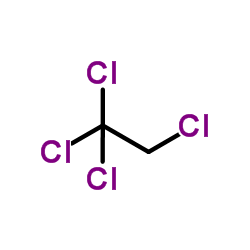tetrachloroethane

tetrachloroethane structure
|
Common Name | tetrachloroethane | ||
|---|---|---|---|---|
| CAS Number | 630-20-6 | Molecular Weight | 167.849 | |
| Density | 1.6±0.1 g/cm3 | Boiling Point | 132.4±8.0 °C at 760 mmHg | |
| Molecular Formula | C2H2Cl4 | Melting Point | -68.1ºC | |
| MSDS | Chinese USA | Flash Point | 35.5±15.8 °C | |
| Symbol |



GHS05, GHS07, GHS08 |
Signal Word | Danger | |
|
Development of QSAR models for predicting hepatocarcinogenic toxicity of chemicals.
Eur. J. Med. Chem. 44 , 3658-64, (2009) A dataset comprising 55 chemicals with hepatocarcinogenic potency indices was collected from the Carcinogenic Potency Database with the aim of developing QSAR models enabling prediction of the above unwanted property for New Chemical Entities. The dataset was... |
|
|
A new analytical method to determine non-steroidal anti-inflammatory drugs in surface water using in situ derivatization combined with ultrasound-assisted emulsification microextraction followed by gas chromatography-mass spectrometry.
Talanta 129 , 552-9, (2014) Because of the high stability and potential toxic effects of non-steroidal anti-inflammatory drugs (NSAIDs), it is important to closely monitor their concentrations in the environment using a sensitive analytical method. In this study, a simple, rapid, effici... |
|
|
Effects of chlorinated aliphatic hydrocarbons on mitochondrial oxidative phosphorylation in the rat with reference to the effects of chlorinated aromatic hydrocarbons.
Ind. Health 19(2) , 71-5, (1981)
|
|
|
Detection and quantification of trace organic contaminants in water using the FT-IR-attenuated total reflectance technique.
Anal. Chem. 82(2) , 505-15, (2010) The Fourier transform infrared-attenuated total reflectance (FT-IR-ATR) technique has been used to detect and quantify the following volatile organic compounds (VOCs) in water: 1,1,1,2-tetrachloroethane, 1,1,2,2-tetrachloroethane, styrene, and tetrachloroethy... |
|
|
1,1,1,2-Tetrachloroethane.
IARC Monogr. Eval. Carcinog. Risk Chem. Hum. 41 , 87-97, (1986)
|
|
|
Differences in rat liver enzyme-altered foci produced by chlorinated aliphatics and phenobarbital.
Toxicol. Ind. Health 2(4) , 351-62, (1986) Nine chlorinated aliphatics (CAs)--1,1-dichloroethane, 1,2-dichloroethane, 1,1,1-trichloroethane, 1,1,2-trichloroethane, trichloroethylene, tetrachloroethylene, 1,1,1,2-tetrachloroethane, 1,1,2,2-tetrachloroethane, and hexachloroethane--were examined in a rat... |
|
|
1,1,1,2-Tetrachloroethane.
IARC Monogr. Eval. Carcinog. Risks Hum. 71 Pt 3 , 1133-41, (1999)
|
|
|
Cooling efficiency of cryogen spray during laser therapy of skin.
Lasers Surg. Med. 32(2) , 137-42, (2003) Cryogen spray cooling (CSC) is used extensively for epidermal protection during laser-induced photothermolysis of port wine stains and other vascular skin lesions. The efficacy of CSC depends critically on the heat transfer coefficient (H) at the skin surface... |
|
|
Influence of anionic cosolutes and pH on nanoscale zerovalent iron longevity: time scales and mechanisms of reactivity loss toward 1,1,1,2-tetrachloroethane and Cr(VI).
Environ. Sci. Technol. 46(15) , 8365-73, (2012) Nanoscale zerovalent iron (NZVI) was aged over 30 days in suspension (2 g/L) with different anions (chloride, perchlorate, sulfate, carbonate, nitrate), anion concentrations (5, 25, 100 mN), and pH (7, 8). During aging, suspension samples were reacted periodi... |
|
|
Use of dithionite to extend the reactive lifetime of nanoscale zero-valent iron treatment systems.
Environ. Sci. Technol. 44(22) , 8649-8655, (2010) Nanoscale zero-valent iron (NZVI) represents a promising approach for source zone control, but concerns over its reactive lifetime might limit application. Here, we demonstrate that dithionite (S₂O₄²⁻), a reducing agent for in situ redox manipulation, can res... |